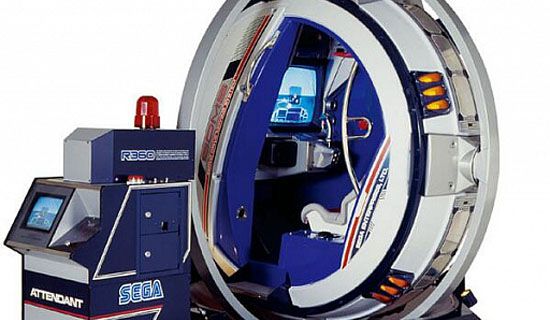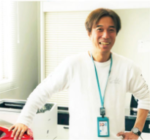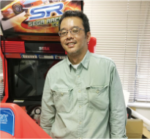Sega was always the first to implement cutting edge ideas and technology into their arcade games, and they’ve continued to shock us over the years. Today we have an interview with two people who have made those very games happen. Just what sort of things have happened behind the scenes during Sega’s history of taking on these technological challenges? These two witnesses to this phenomenon talk about this seldom discussed topic!
Masao Yoshimoto (Council to the Sega’s Planning, Creation and Production Departments) – Joined the company in 1987, and has been involved in developing “R360”, “UFO Catcher” and various medal games as an electro-mechanical professional. Currently he serves as a leader in the development of arcade cabinets.
Makoto Osaki (Head of second department of fifth development division of Sega Japan Asia Studio) – Joined the company in 1993, and participated in the development of games such as the “Virtua Fighter” series and “Daytona USA” as a part of AM2. He’s also served as the producer for “Hatsune Miku Project DIVA Arcade”.
Hunger For Technology From the Electro-Mechanical Era
You can’t avoid the phrase “challenges” when you talk about Sega’s history. What have your impressions been of that, given that you’ve both been involved in countless arcade machines going to market over the years?
(Yoshimoto) From the perspective of someone in the engineering department, I think Sega has always been a company to quickly adopt the most cutting edge technologies. For example, they were the first to use laser disc technology in the arcade with “Astron Belt” in 1983.
Speaking of 1983, was that when Sega made karaoke machines were finally using laser discs as well? Of course development had begun on both of those things previously…but they were both so early on.
(Yoshimoto) That’s right. Sega has always been a company that’s been hungry for technology, even before they were making video games. They made the karaoke machines that were popular before laser discs too, the ones that used 8-track tapes.
Wow.
(Yoshimoto) There was even an electro-mechanical game that they made in 1968 called “Motopolo”, where you moved motorcycles around.
(Osaki) You moved them around inside the cabinet and played by knocking these balls around with them. It was a bit like air hockey.
(Yoshimoto) It even had an 8-track player in it to play back the sound of a motorcycle running on a loop.
For reference, it seems that the 8-track was developed in 1965. So it would have been very cutting edge at that time.
(Yoshimoto) It definitely seems like the company way was to have a strong fixation on audio. They were even very particular about analogue sound sources back in the “Periscope” area as well. Although the sound was actually the vibration of the spring being picked up by a mic and amplified…or something similar to that.
To think they were doing things like that ever since the electro-mechanical era! What comes to mind for you when it comes to Sega’s history of taking on challenges, Mr. Osaki?
(Osaki) Their speed of releasing games right from the planning phase was just so much faster than everyone else. “After Burner” was inspired by the movie “Top Gun”, which of course was very popular. “Top Gun” came out in theaters in 1986, but “After Burner” came out as soon as 1987! (Laughs)
(Yoshimoto) So they made a huge moving cabinet like that in only a single year, how dirty!
Definitely! (Laughs) It was done amazingly fast.
(Yoshimoto) “Hang-On” was definitely influenced by a very popular race going on at the time called the GP500. It’s obvious at this point, but they were very aware of things that were going on in the world.
The Development of the Legendary R360 Cabinet
As a company that was good at creating arcade games as experiences, the R360 was a high point for Sega. Do either of you have any memories from that time?
(Yoshimoto) I have a lot memories of the R360. It started with Hisashi Suzuki telling me that they had this machine in Australia that spun around, and to go see what it was all about. It all started with me flying there to see it.
I see. So you made it by incorporating those mechanisms into a cabinet?
(Yoshimoto) Of course we didn’t do it through ordinary means. Power has to be supplied to two rings so that it could spin indefinitely, and there wasn’t really anything we could use to do that. We searched for all sorts of parts, but ultimately we ended up customizing parts from a military-use radar in order to make it! (Laughs)
What a crazy way of getting materials! (Laughs)
(Yoshimoto) There was also a 20 inch CRT monitor in the R360, which had no manufacturer warranty on it.
(Osaki) Of course not, the thing was spinning around all the time so there’s no way they could have.
That would definitely be out of warranty! (Laughs)
(Yoshimoto) Thinking about the equipment in the event of an emergency stop, at least 3G of force would be on the monitor. So as far as what would happen…well it would break, wouldn’t it.
(Osaki) I suppose it would.
(Yoshimoto) And we tried asking the manufacturer what would be the most likely parts to break if it was spinning, but of course they didn’t give us an answer. And we broke so many monitors putting them into prototype cabinets to test them, so we also had the job of reinforcing the weaker parts ourselves so that they wouldn’t break.
How ridiculous! (Laughs)
(Yoshimoto) The unexpected part was that the CRT was being effected by geomagnetism. So when it spun around the monitor would go completely red or blue. We acknowledged it from an engineering perspective, but actually we didn’t even notice it ourselves until it was actually all up and running.
Huh!?
(Yoshimoto) If you pressed the demagnetization button, it would temporarily reset things and prevent the colors from changing. But…the R360 was constantly spinning around, right? So in trying to figure out what was going on, there was an engineer that looked like he hadn’t slept in awhile who finally said “We just have to be constantly demagnetizing while the thing is moving, right?”.
With all the enthusiasm of a revelation from someone who hasn’t slept?
(Yoshimoto) Yeah. At first we wondered if we could even do that, but it ended up working. So we finally ended up with a finished product, which ended up being a machine that just ate up a ton of power. It was the first cabinet to use a 200 volt power supply.
(Osaki) That’s basically an AC unit! (Laughs)
Immersed In New Technology! The Business Order is “Be the World’s First”
Were there a lot of cases where you were working with cutting edge technology at the time, but now it would just be considered everyday stuff?
(Yoshimoto) One example would be “Derby Owners Club”, which was a game that saved data to a magnetic stripe card. It was released in 1999, and at that point…I’m not even sure that pachinko halls were using magnetic stripe cards.
That was definitely a revolutionary technology.
(Yoshimoto) “World Club Champion Football” had a flat screen display, but actually it was the first cabinet to use a DLP projector, which were only for business or manufacturing use back then. It came out in an era where no one even knew what the “D” in “DLP” stood for.
(Osaki) We were also very early with VR technology.
(Yoshimoto) Ahh, VR-1.
That was a game that could be played at Joypolis, right?
(Osaki) Yeah. As I recall it had already begun development as early as 1993. So to put things in perspective, this was a VR game in the era of the Super Famicom and Mega Drive, when 3D meant putting on glasses with red and blue lenses.
As usual, Sega was there too early! (Laughs)
(Yoshimoto) Several years earlier people started talking about “the first year of VR”, and that made us say “Just how late to this are we?!” (Laughs)
(Osaki) Nintendo’s Gunpei Yokoi always talked about “withered technology”, and we were the complete opposite of that! (Laughs)
Opposite-Gunpei! (Laughs)
(Osaki) Sega’s arcade divisions loved new things to an abnormal degree. If it was a new technology, we’d force ourselves to use it.
(Yoshimoto) Hisashi Suzuki would tell us “We’ve got to have something that we can say we were the first in the world to do!”.
(Osaki) Yeah. The business order being “be the world’s first” was sometimes a bit unreasonable! (Laughs)
(Laughs)
(Yoshimoto) And since we kept on developing in that way, we never realized just how far ahead of the rest of the world we were.
(Osaki) But feeling futuristic was important back then.
(Yoshimoto) Yeah, that’s true. It was a time when you could earn an income just by being futuristic (Laughs)
This may not be an era in which new technology comes about that easily, but we’re hoping that you’ll continue showing us that same sense of being futuristic!


